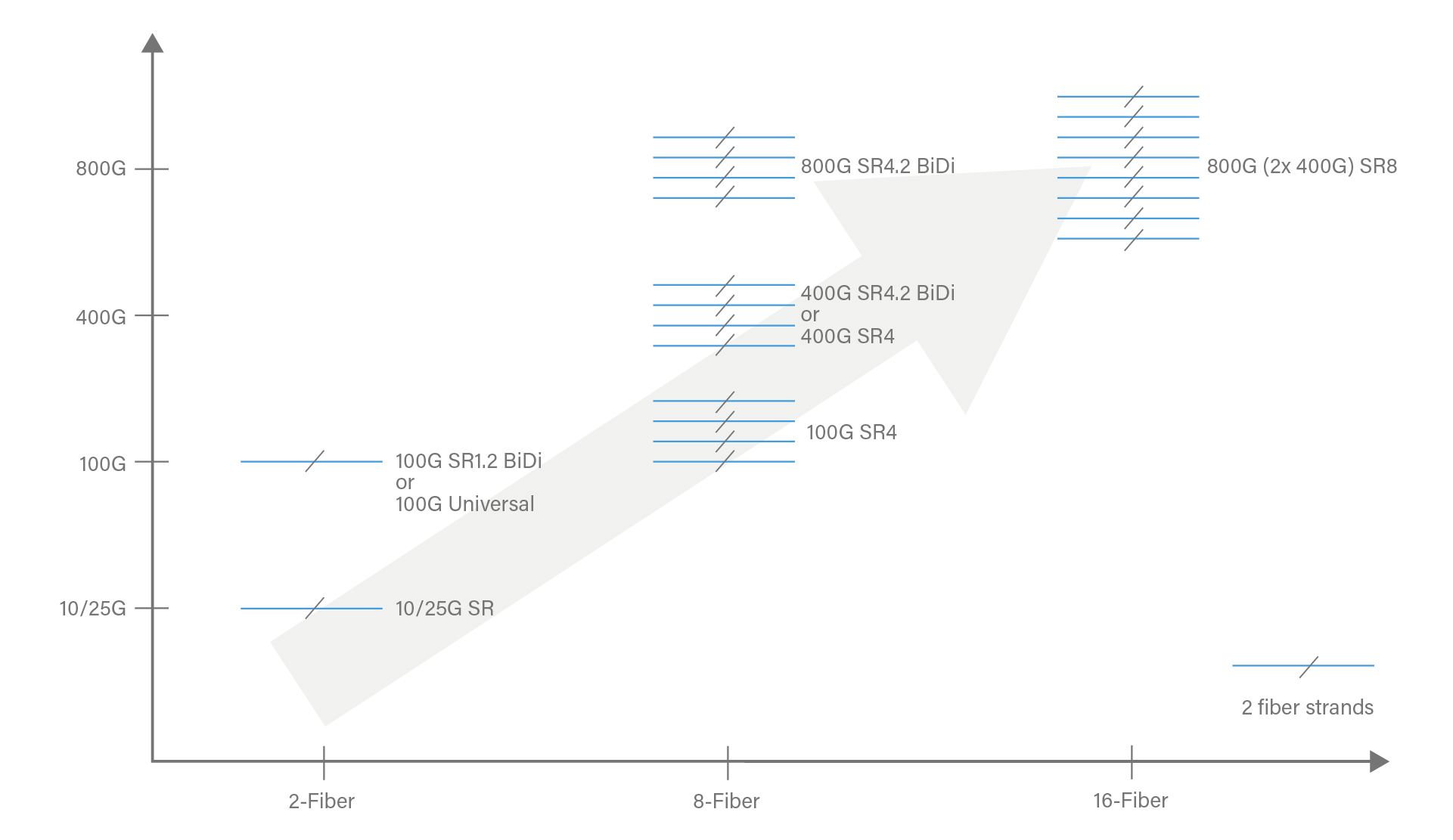Future-Proof Your Network: Strategies for Migrating to 800G
Posted by Lakeisha Turks on Oct 14, 2025

The digital world is accelerating at a pace that pushes data centers to their limits. Artificial intelligence, cloud computing, streaming services, and IoT are driving unprecedented demand for bandwidth, speed, and efficiency.
Network architects and engineers’ most critical challenge is designing infrastructure that meets today’s requirements while scaling seamlessly to meet tomorrow’s demands. That means preparing for the transition from 10G to 400G, 800G, and beyond, without frequent, costly overhauls.
By building a robust, forward-thinking multimode fiber plant today, you can ensure your network is ready to handle emerging workloads, new applications, and evolving technologies for years to come.
Understanding Optics and Fiber Strand Requirements
Understanding the optics landscape at each stage of network evolution is essential for future-proofing your data center. The chart below is a useful reference for planning the migration path from your existing fiber plant to future-ready environments. It illustrates the multimode fiber strand requirements for current and upcoming short-reach optics.

A practical starting point is an 8-fiber or 16-fiber plant, both of which establish a clear pathway toward 800G capacity. A 16-fiber configuration offers even more flexibility. It can be split into two 8-fiber segments or broken down into multiple 2-fiber links, allowing you to scale and reconfigure for different network needs.
Choosing the Right Optical Transceivers for Migration
When mapping out your migration, combining 100G SR1.2 bidirectional (BiDi) and 400G SR4.2 fiber optics offers a highly efficient path to 800G performance while conserving fiber strands. These transceivers offer roughly 50% fiber strand savings compared to non-BiDi fiber optics. The 400G SR4.2 module adds versatility with its ability to break out into four 100G SR1.2 connections, ideal for server clusters that still operate at 100G. Additionally, the 100G Universal optic supports distances of up to 100 meters over multimode fiber and up to 2 kilometers over single-mode fiber, expanding your design flexibility across diverse deployment scenarios.
Designing a Future-Proof Multimode Fiber Plant
Long-term scalability begins with a well-designed multimode fiber plant built to accommodate higher speeds. A proper fiber count infrastructure ensures that you can adapt to faster optics without major infrastructure replacement. Traditional multifiber push-on (MPO)/ multifiber termination push-on (MTP) connectors remain critical, but newer Very Small Form Factor (VSFF) connectors—such as mini duplex connectors (MDC) and Senko Nano (SN)—are becoming increasingly valuable for high-density, space-efficient fiber management.
A structured cabling system is equally vital, providing the flexibility and manageability needed for upgrades without total rewiring. Parallel fiber architectures further enhance bandwidth by transmitting data simultaneously over multiple fibers. With the right configuration, even a 12-fiber plant can be reallocated into three 8-fiber lines, giving you adaptable pathways to higher speeds as demand grows.
Key Fiber Plant Considerations
Migrating from 10G to 800G requires attention to more than just fiber counts—technical details determine real-world performance. Be sure to evaluate:
- Optical power budget and link loss – Design for realistic signal strength and minimal attenuation.
- Multimode fiber type (OM3, OM4, OM5) – Select fiber that meets both reach and throughput requirements.
- Polarity standards (Method A/B/C) – Maintain compatibility across optics and connectivity.
- Connector types and quality – Use connectors with low insertion loss, high return loss, and robust mechanical durability to ensure consistent performance, minimize downtime, and reduce long-term maintenance.
Conclusion
To build a multimode fiber infrastructure ready for 800G migration, precision in planning is key. Starting with structured cabling, selecting the right fiber counts, and incorporating flexible connectors and architectures ensures your plant can handle future high-speed demands without constant rip-and-replace cycles. Thoughtful investment now in a scalable, manageable cable infrastructure empowers data center teams to stay ahead in the evolving landscape of high-speed networking.
With our engineering expertise, broad compatibility, and customizable solutions, Approved Networks can guide you through every step of the process—from design to implementation—to ensure a smooth, cost-effective, and future-ready network.
Contact us today to start planning your path to 800G.